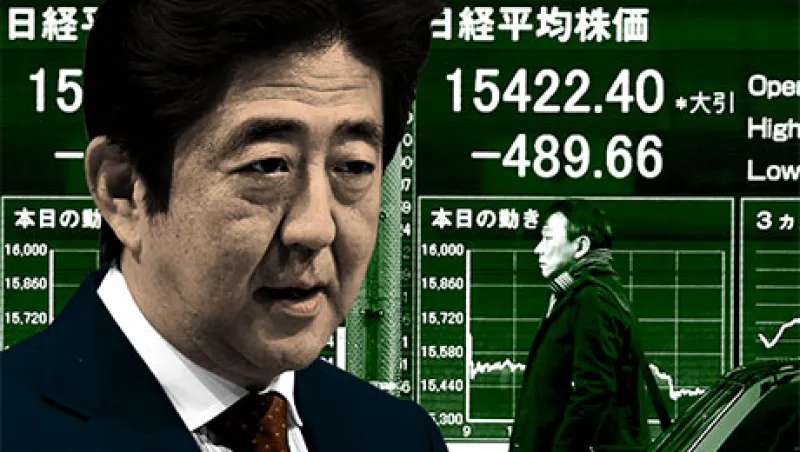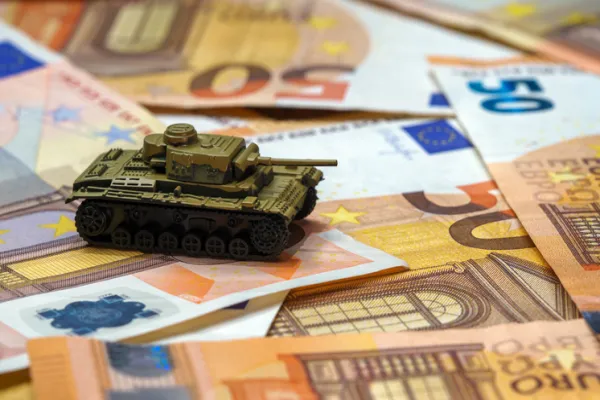When Prime Minister Shinzo Abe launched his economic reform program a year ago, he hoped to change psychology as much as anything else, considering that a vital step to breaking Japan’s long deflationary slump. Signs are that he’s succeeding.
When I polled a group of global macro traders last June about the outlook for Japan, they were almost evenly divided, with 52 percent betting that Abenomics, as the prime minister’s policies are known, would succeed in reflating the economy and 48 percent disagreeing. Since then Japan’s consumer price index has accelerated, with core inflation hitting a five-year high of 1.2 percent in November. In January the Bank of Japan predicted that core inflation would rise to 1.9 percent in the fiscal year beginning in April 2015, within a whisker of the 2 percent target set by BOJ Governor Haruhiko Kuroda (see also “ Small-Cap Growth in Japan Hints at Success of Abenomics”).
Optimism among global macro traders has risen in step with the data. A poll of three dozen traders in December produced the following forecasts:
- It’s a 1-in-5 probability that Japan’s core inflation rate will exceed Kuroda’s 2 percent target in 2014, a 50-50 chance that the CPI will rise between 1 percent and 2 percent, and 1 in 3 that inflation will be below 1 percent.
- The odds are 28 percent that gross domestic product will expand by more than 3 percent, 48 percent that it will grow by between 0.5 percent and 3 percent, and 25 percent that growth will be below the 0.5 percent mark.
- There is a 1-in-3 chance that the yen will depreciate to trade above 110 to the dollar, a 45 percent chance it will trade between 95 and 110, and a 1-in-5 probability that it will appreciate to a rate below 95 to the dollar.
Our traders agree that the single most dangerous tail risk for the Japan trade is that sustained fiscal deficits, even assuming the Abe government goes ahead with its planned hike in value-added tax this spring, will destabilize the market for Japanese government bonds (JGBs). With the country’s gross debt standing at a towering 240 percent of GDP, that’s no small concern. Subtracting Japanese government debt held by other agencies for pensions reduces the net debt figure to 135 percent of GDP, but that’s still very high. For the sake of comparison, U.S. government gross debt stands at 105 percent of GDP, and Greece’s is at 160 percent. An increase in the interest rate on JGBs would blow a huge hole in the already stressed budget of the Japanese government, a quarter of which goes to servicing interest on its debt.
Yet even if our traders regard such a scenario as frightening, they agree (on average) that it is unlikely to occur in 2014 because Kuroda’s BOJ is buying huge amounts of JGBs through its own version of quantitative easing. “I didn’t bet against Ben Bernanke in the Treasury market because he had more dollars than I have, or even Pimco has,” mused a London-based trader. “Kuroda has more yen than I have, too.”
When a country’s nominal GDP growth rate exceeds the nominal interest rate on its debt, the government can stabilize its debt burden and then, over time, grow out from under the overhang. So the Abe government clearly needs to deliver a GDP growth rate higher than the JGB rate. If it fails, the JGB market will eventually crush bondholders (and the Abe government).
“People don’t realize the enormity of the situation in Japan,” says Kyle Bass, founder and principal of Hayman Capital Management, a perma-bear when it comes to Japanese debt sustainability. “They have $14 trillion worth of debt, which is about the same as the U.S., except they have a little more than a third of our population. We are about to see what a heavily indebted Western society looks like when it implodes or explodes. The seminal event in the world in the next couple of years will be Japan.”
Ominously, a recent study by the Organization for Economic Cooperation and Development revealed that Japanese banks’ holdings of general government securities equal 100 percent of their tier-1 capital. According to the study, a 1 percentage point upward shift of the JGB yield curve would wipe out 70 percent of this tier-1 capital. An earlier Bank of Japan study estimated that a 1 percent rate rise would wipe out only 15 percent of banks’ tier-1 capital.
The other dangerous tail risk for Japan’s economic recovery in 2014 is a potential military clash with China over the Senkaku Islands, a small group of uninhabited islands in the East China Sea that Beijing, which calls them the Diaoyu Islands, also claims. In the June poll, traders assigned odds of 1 in 5 to a serious military clash — involving loss of ships or planes and more than 25 fatalities — between China and one of its maritime neighbors during 2013. No clash took place, but China has been escalating tensions over the islands. On November 23, Beijing’s sudden unilateral declaration of an Air Defense Identification Zone (ADIZ) over the disputed area sent a tremor through financial markets. The move was accompanied by tough words from Beijing. “China’s armed forces will adopt defensive emergency measures to respond to aircraft that do not cooperate in the identification or refuse to follow the instructions,” the Defense Ministry said in a statement.
“The Abe government is unlikely to bend to Chinese pressure on the Senkakus,” predicts one Tokyo-based trader, who pointed to the prime minister’s public statements and his December visit to Yasukuni Shrine. The shrine, a memorial for Japanese soldiers, includes the remains of several World War II war criminals and is widely viewed as a red flag to Beijing. “The prime minister is a proud nationalist and campaigned on a conservative national security agenda.” If this prediction is correct, then Japan’s Self Defense Forces will increase their patrols, both maritime and aerial, around the islands, increasing the risk of a collision or shoot-out with the People’s Liberation Army of China.
I was in New Delhi watching India’s Republic Day parade on January 26, an event at which Prime Minister Abe was the chief “distinguished guest.” The Indians put on a display of everything from goose-stepping turbaned commandos to Russian-sourced T-90 battle tanks and cruise missiles, climaxed by a deafening flyover of Sukoi-30 fighter-bombers. Just a month ago, the Japanese military and the Indian navy conducted their first bilateral exercises in the Indian Ocean, much to the annoyance of the Chinese.
Interestingly, data analytics suggests that defying China has a positive effect on Japanese markets, which seems counterintuitive, at least to me. Kensho is a Cambridge, Massachusetts–based start-up that uses software techniques pioneered by Google (where many of the founders worked) to calculate the effect of political and economic events on asset prices with blazing speed. (Full disclosure: I serve on the company’s advisory board.)
A Kensho study performed in October 2013 predicted an uptick in the Japanese stock market generally and entities of the Mitsubishi Group in particular (as a proxy for leading defense contractors) based on market reactions to Yasukuni visits by previous prime ministers. The average gain in the IShares MSCI Japan exchange-traded fund (EWJ) was 2 percent during each visit, whereas shares in Mitsubishi UFJ Financial Group (MTU) showed an even more striking 4 percent uptick. In the two days following Abe’s surprise December 26 visit to Yasukuni, EWJ rose 1.6 percent and MTU gained 2.71 percent.
In contrast to this positive impact on equities, rising tensions with China could have longer-term negative effects on Japan’s exports. China accounts for one third of Japan’s exports, and a serious clash in the East China Sea would cause another backlash, like the public outcry and boycott of Japanese goods that occurred in China after the Japanese government bought some of the Senkakus from their private owners in September 2012 in a bid to keep ultranationalists at bay.
The forward-looking traders’ poll for 2014 assigns the same 1-in-5 probability to a serious clash between Chinese forces and those of her neighbors in the Association of Southeast Asian Nations or Japan. Such odds about a possible fight between Japan and its largest export market is enough to keep a trader long yen and JGBs awake and anxious in the wee hours.
Though often ignored in this equation, South Korea is also part of the three-way claim over the East China Sea around the Senkakus, and South Korea responded with its own ADIZ claim in response to the Chinese announcement. It was an unintended act of solidarity with Japan, with whom the government of President Park Geun Hye had tense relations throughout 2013. But viewed from Seoul, the risk of an incident over the disputed islands is much less than the threat of another provocation from the brutal North Korean regime of Kim Jong Un.
The purge and brutal execution of Kim’s uncle, Jang Song Thaek, on December 12 suggests that Kim may have consolidated power — or that fissures within the regime continue to threaten its survival. In the former case, the removal of Jang will leave Kim with no adult leadership to constrain his actions, including possible military provocations, during 2014. In the latter case, continued infighting in Pyongyang or even a potential coup would hardly inspire confidence. At this point tattooed basketball legend Dennis Rodman may have more insight into Kim’s real intentions than does Pyongyang’s Politburo.
In the June 2013 poll, the mean forecast for another bloody-minded incident by the Kim government was 14 percent. Jang’s execution has apparently caused traders to up that risk. The December poll assigns a slightly higher 18 percent probability of provocations by the North in 2014.
“The main risk in 2014 on the Korean peninsula is a successful uranium-based nuclear test or a long-range missile test that demonstrates a deliverable nuclear warhead capability, with a 30 percent to 40 percent probability,” says Victor Cha, a professor at Georgetown University who served on George W. Bush’s National Security Council, where I worked with him on Korea policy from across the Potomac at the Pentagon. “A slightly higher risk but lower-probability event in 2014 is a conventional military altercation between the two Koreas, for example in the West Sea area, that could escalate, with a probability between 20 percent and 30 percent. The highest risk but with the lowest probability is internal instability in North Korea stemming from leadership struggles and political discontinuities, not from famine or economic downturns, with a probability of 10 percent.”
Strikingly, recent history suggests it would take a big provocation by Pyongyang to roil financial markets. South Korean equities and the won have become increasingly insensitive to North Korean incidents, even nuclear tests, shrugging off the effects quickly, as Kensho studies demonstrate. Using a list compiled by Professor Cha of 11 milestones in North Korean activity between 2006 and 2013, a Kensho study shows that the South Korean stock market used to take a hit in response to each provocation until 2010, when the IShares MSCI South Korea Capped ETF (EWY) began to respond positively to each North Korean event. Apparently markets concluded that Pyongyang is more interested in blackmail for economic aid than in launching Armageddon.
James Shinn (jshinn@princeton.edu) is lecturer at Princeton University’s School of Engineering and Applied Science and CEO of Teneo Intelligence. After careers on Wall Street and in Silicon Valley, he served as the national intelligence officer for East Asia at the Central Intelligence Agency and then as assistant secretary of defense for Asia at the Pentagon. He serves on the advisory boards of Oxford Analytica; Kensho; and CQS, a London-based hedge fund.
Also from this series:






